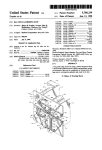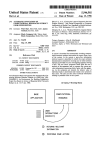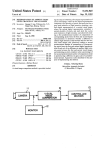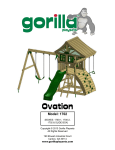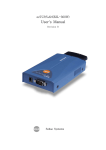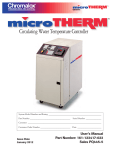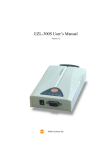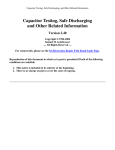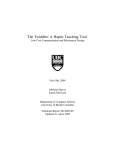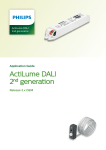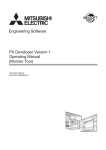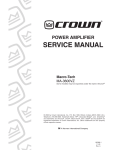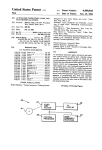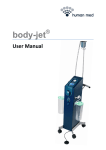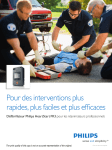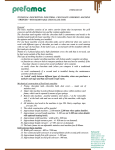Download Ribbon sensing device for bag tyer
Transcript
lllllllllllllllllllllllllllllllllllllllllllllllllllllllllllllllllllllllllll USOO5483134A United States Patent [19] [11] Patent Number: Frazier et al. [45] [54] RIBBON SENSING DEVICE FOR BAG TYER Date of Patent: [56] U'S' PATENT DOCUMENTS Richardson, Oklahoma City; Greg R Coxsey, Norman, all of Okla. 3,059,670 10/1962 Burford et al. . 3,138,904 6/1964 Burford . 3,919,829 Assignee: Burford Corporation, Maysville, Okla. [21] APPL N0-3 129,284 [22] Filed: Sep_ 30, 1993 Jan. 9, 1996 References Cited [75] Inventors: Jimmy R. Frazier, Norman; John D. [73] 5,483,134 11/1975 Burford et al. ......................... .. 53/135 4,277,731 7/1981 Pongracz ....... .. 4,856,258 8/1989 Burford et al. ..................... .. 53/138 A 318/562 X Primary Examiner-David S. Martin Attorney, Agent, or Firm—Crutsinger, Booth & Kanz [51] int. ciP ..................................................... .. GOSB 5/00 [57] [52] US. Cl. ........................ .. 318/468; 318/626; 318/640; A bag neck tying device for tying a ribbon dispensed from 53/ 138.8; 53/583 a spool about a gathered neck. A pulley and proximityv switch [58] Field of Search ............................... .. 53/l38.l—138.3, 53/138.6—l38.7, 138.8, 139.4, 583, 203; 318/560, 561, 567, 568.1, 569, 626, 445, 449—450, 466—470 ABSTRACT are mounted to prevent the completion of a tying cycle if a bag neck is not properly gathered and ready to be tied. 10 Claims, 13 Drawing Sheets US. Patent Jan. 9, 1996 Sheet 1 of 13 5,483,134 US. Patent Sheet 2 of 13 Jan. 9, 1996 5,483,134 com '5 , V3 K\ m.UE US. Patent Jan. 9, 1996 Sheet 3 of 13 5,483,134 FIG.3 US. Patent Jan. 9, 1996 Sheet 4 of 13 M1 FIG. 4 5,483,134 U.S. Patent Jan. 9, 1996 Sheet 5 of 13 E1 5,483,134 16 30 44 /‘ 40 42 31 24 22 45 80 34 33 58 55 18 38 FIG. 5 US. Patent Jan. 9, 1996 Sheet 6 of 13 5,483,134 6FIG. US. Patent Jan. 9, 1996 ' Sheet 7 of 13 5,483,134 /-90 8V DC DC I f 94 6 60 i ,/ 75a O O x 62 TTTm 4@wjlLJ M \ @ E T.>R16m sN FM mm 3 mB \ElZl__f I H FIG. 7 Y i 4 I) q; O K 0 \El llm US. Patent Jan. 9, 1996 Sheet 11 of 13 5,483,134 2600 2400 2000 1800 1600 1400 1200 1000 / 800 RPM NEEDLE] 600 400 200 —200 KSHEAR —600 —800 —1000 ~1200 —1400 —l600 0 .02 .04 .06 .08 .10 .12 .14 .16 .18 I .20 .22 24 .26 .28 SECONDS FIG. 11 .30 US. Patent Jan. 9, 1996 Sheet 12 of 13 415 ‘in mm’ 5,483,134 US. Patent Jan. 9, 1996 Sheet 13 of 13 5,483,134 FIG. 14 5,483,134 1 2 RIBBON SENSING DEVICE FOR BAG TYER gathered materials in addition to the speci?c disclosed embodiment of the bag neck tying device. TECHNICAL FIELD DESCRIPTION OF THE DRAWINGS The invention relates to apparatus for wrapping a ribbon around the gathered neck of a bag and twisting the ribbon for closing and sealing the neck of a ?exible bag. Drawings of a preferred embodiment of the invention are annexed hereto so that the invention may be better and more fully understood, in which: BACKGROUND OF INVENTION FIG. 1 is a perspective view illustrating the front of the bag neck tying device; U.S. Pat. No. 3,138,904 to Earl E. Burford entitled “METHOD AND APPARATUS FOR TYING PACKAGES AND WRAPPING MATERIALS;” U.S. Pat. No. 3,059,670 FIG. 2 is a diagrammatic front elevational view; FIG. 3 is a diagrammatic rear elevational view; FIG. 4 is an end view looking generally in the direction of the arrows along line 4-4 in FIG. 2; FIG. 5 is a diagrammatic end view illustrating the dis to Charles E. Burford and Leonard W. Burford entitled “WIRE TWISTING TOOL;” U.S. Pat. No. 3,919,829 to Leonard W. Burford and Charles C. Burford entitled “APPA RATUS FOR TYING PACKAGES AND WRAPPING charge end of the bag neck tying device, looking in the MATERIALS;” and U.S. Pat. No. 4,856,258, which issued Aug. 15, 1989 to Charles E. Burford and Jimmy R. Frazier entitled “WIRE TYING DEVICE” disclose apparatus used direction of the arrows along line 5-5 in FIG. 2; FIG. 6 is a top plan view, looking in the direction of the arrows along line 6—6 in FIG. 2, parts being broken away to more clearly illustrate the details of construction; FIG. 7 is a wiring diagram of the closed loop microcom for closing a plastic bag by attaching and twisting a wire-like ribbon about the neck of the bag. Bag tying devices of the type disclosed in the aforemen tioned patents are commercially available from Burford Corporation of Maysville, Okla. The tying devices are generally constructed to receive packages such as loaves of puter controlled control system; 25 FIG. 8 is a schematic diagram of the full wave recti?ed 8 and 34 volt power supply; FIG. 9 is a schematic diagram of a bi-directional DC motor controller; careful consideration of the mass, acceleration, deceleration FIG. 10 is a schematic diagram of a single direction DC and momentum of the moving parts of the tying device. 30 motor controller; Further, precise synchronization of parts in subassemblies of FIG. 11 is a graphic representation of the sequence of the tying devices must be maintained throughout a tying operation of the needle, hook and shear assemblies during a bread at speeds of for example one hundred (100) packages per minute. The design of the bag tying devices requires cycle if the device is to operate effectively. SUMMARY OF INVENTION complete cycle of operation; FIG. 12 is a diafframatic front elevational view of the 35 The bag neck tying device disclosed herein incorporates a bag neck gathering mechanism comprising motor driven gathering belts for moving a bag neck along a path in a plane into engagement with a bag stop controlled by an electric brake positioned adjacent a ribbon holder-shear assembly proximity switch; and FIG. 14 is a perspective view of a holder-shear assembly. Numeral references are employed to designate like parts which holds the free end of a ribbon of tie material. A motor driven needle wraps the strand of tie material around the gathered neck of the bag, and a motor driven twister hook assembly engages the free end and the running end of the ribbon adjacent the gathered neck for twisting the ribbon. Independently controlled bi-directional, brush type ser throughout the various Figures of the drawing. 45 numeral 10, in FIGS. 1 and 2 of the drawing is mounted adjacent the side of a conveyor 300 of the type disclosed in Burford U.S. Pat. No. 3,138,904 and Burford U.S. Pat. No. 3,919,829, the disclosures of which are incorporated herein by reference in their entirety for all purposes. Conveyor 300 carries for example, loaves 125 of bread to, through and out of wire tying device 10 in rapid succession. Conveyor 300 tying device. Each of the servomotors is controlled by a solid state DC motor controller in a closed loop feedback system under the control of a multi-channel microcontroller which precisely starts, controls and stops each of the ser vomotors in a pre-assigned sequence for each cycle of the tying apparatus. 55 the software driven motor controllers isolate the movement further structures may form the conveyor. 60 material, such as plastic bag material or a variety of other materials such as coils of electrical cord, water hose, tubing, yarn, and bundles of cable, rods, or carrots, and in apparatus for fastening the gathered material. It is contemplated that the disclosed closed loop control circuit may be used to control electric motors to drive apparatus for fastening is well known to persons skilled in the art and further description thereof is not deemed necessary except in con nection with the drive mechanism as will be hereinafter more fully explained. It should be appreciated that other and of the various components of the tying device to reduce stress and shock loading of parts of mechanical drive trains. A preferred embodiment of the apparatus for securing material includes improvements in apparatus for gathering DESCRIPTION OF A PREFERRED EMBODIMENT The wire tying device, generally designated by the vomotors are mounted in the separate :subassemblies of the The weight and number of moving parts in the tying device have been signi?cantly reduced. More particularly, tying device with belt guards and covers in position, illus trating a spool of ribbon; FIG. 13 is a diaffrarnatic perspective view of a pulley and 65 Referring to Figure I of the drawing, the numeral 20 generally designates a bag gathering apparatus for moving a bag 125 along a path 12 to a position adjacent a needle assembly 40, a twister hook assembly 50 and a holder-shear assembly 60. As will be hereinafter more fully explained, the free end of a ribbon of wire-like material 15 is gripped in holder-shear assembly 60. The neck of the bag moves through a slot 122 between upper face plate 16 and lower 5,483,134 3 4 face plate 17 for drawing the bag 125 to a controlled tension about the contents thereof. Needle assembly 40 wraps the ribbon 15 of the wire-like material about the gathered neck of the bag and twister hook 50 is actuated for twisting a portion of the wire-like material about the neck of the bag 125. It should be noted that the ribbon of material 15 may pulleys 36, 37 and 38. As best illustrated in FIG. 1 of the be constructed of wire enclosed in paper or plastic or it may comprise a ribbon of plastic or any other material. The strand of ribbon 15 extends around one or more pulleys 41, 41a and 41b mounted on shafts 41a’ from a spool 41c of tie material, as best illustrated in FIG. 12. The mounting for spool 41c is similar to that disclosed in US. Pat. No. 3,919,829 entitled “APPARATUS FOR TYING PACKAGES AND WRAPPING MATERIALS”, the disclosure of which is incorporated herein by reference in its entirety for all purposes. However, it will be noted that spool 410 of tie material is mounted on a shaft and tie material 15 is fed from spool 14c and is routed around rollers 41b, 41a and 41, around needle roller 44 and the end of the ribbon 15 is gripped in the holder-shear assembly 60, as best illustrated in FIGS. 1 and 14 of the drawing. Spool 41c is mounted on a shaft engaged by a brake (not shown). As needle 42 forms a loop of tie material around the gathered neck of a bag, the force of inertia and force exerted by the brake cause the spool 41c to remain stationary momentarily drawing, the portion 29 of the upper gathering belt 22, extending between idler pulleys 27 and 2.8, is substantially parallel and closely spaced relative to the portion 39 of the lower gathering belt 32 which extends between driven pulley 34 and idler pulley 36. In the illustrated embodiment, gathering belts 22 and 32 move a bag neck along path 12 in a plane P as illustrated in FIG. 2. A pressure pad 21, resiliently urged upwardly by springs 21a and 21b acting 10 through bell cranks, maintains belts 22 and 32 in frictional engagement with the neck of a bag or other material to be tied. As best illustrated in FIGS. 3 and 5 of the drawing, driven shaft 25, having driven pulley 24 mounted on one end, has a pulley 23 mounted on its opposite end. Driven shaft 35, having driven pulley 34 mounted on one end, has a pulley 33 mounted on its opposite end. A pulley 30 mounted on the drive shaft of motor M1 drives pulleys 23 and 33 through a belt 31 such that driven pulley 24 rotates in a clockwise 20 direction while driven pulley 34 rotates in a counterclock wise direction, as viewed in FIG. 2 of the drawing. Belt guards 16a and 16b and 17a preferably extend between the gathering belts and products on the conveyor, as illustrated in FIG. 12. The bag neck is moved into a slot in the belt as a crank arm, on which roller 41a is mounted, is rotated in 25 guard by brushes (not shown) and the product in the bag a clockwise direction as illustrated in FIG. 12 of the draw engages the belt guards when the neck of the bag is drawn mg. As will be herein;after more fully explained, one of the pulleys 41, 41a or 41b is preferably equipped with a sensor device which is capable of calculating the amount of ribbon 15 dispensed from spool 41c. The sensor apparatus deter mines whether or not a bag neck is present. As needle 41 moves from the full outline position illustrated in FIG. 2 to the dashed outline position, if a bag neck is not positioned in the path of the ribbon, the cycle of operation will be interrupted so that the holder-shear assembly 60 will not be actuated and the twister hook assembly 50 will not rotate. This prevents actuation of the holder-shear assembly which would have resulted in the ribbon being dropped or released by gathering belts 22 and 32 around a bag stop lever 80. It should be appreciated that other and further gathering struc 30 clockwise, counter when used in reference to the drawings, generally refer to orientation of the parks in the illustrated embodiment and 35 not necessarily during use. These terms used herein are meant only to refer to relative positions and/or orientations, for convenience, and are not to be understood to be in any manner otherwise limiting. As illustrated in FIGS. 7 and 10 of the drawing, motor M1 is driven by a solid state DC motor controller 91 which is The frame of the bag tying device may assume many con?gurations. In the illustrated embodiment upper and lower face plates 16 and 17 are supported on forward edges capable of varying the speed of motor M1 to substantially synchronize movement of upper gathering belt 22 and lowering gathering belt 33 with the speed of a conveyor 300 of vertically extending end plates 18 and 19 having slots moving packages 125 adjacent the bag gathering mechanism formed therein to permit passage of a bag neck. A horizontal 45 outwardly from end plate 18. A motor M1, having an encoder E1 mounted the rear end of motor M1, is mounted on an upper portion of the vertical mounting plate 16a for driving the gathering assembly 20. A Terms such as “left,” “right, clockwise,” “horizontal,” “vertical,” “up,” and “down.” if a bag neck was not present. mounting plate 19a extends between lower portions of end plates 18 and 19 and a vertical mounting plate 16a extends tures may be used to form a gathered neck on a bag. 50 20. For example, if the tier 10 is to gather and tie the necks of 100 bags per minute, the conveyer 300 would preferably bring bags to and through the tier at a speed of approxi mately 300 feet per minute and the gathering belts 22 and 32 would preferably be driven at a speed of, for example 305 feet per minute, so that the neck of the bag would be accelerated for gathering the neck, stopped momentarily motor M2, having an encoder E2 mounted the rear end and a gear box 46 mounted on the front end of motor M2, is mounted on an upper portion of the rear surface of face plate while it is being tied with a ribbon and then discharged in a substantially continuous operation. 16 for driving the needle assembly 40. A motor M3, having As will hereinafter be more fully explained, the gathering an encoder E3 mounted the rear end of motor M3, is 55 assembly 20 also includes a bag stop lever 80, illustrated in mounted vertically on horizontally extending mounting FIGS. 2 and 3, mounted on shaft 85 for rotary movement plate 19a for driving the twister hook assembly 50. A motor about a horizontal axis, in the illustrated embodiment. Shaft M4, having an encoder E4 mounted the rear end of motor 85 extends through an electric brake 82, which momentarily M4, is mounted on a lower portion of end plate 18, and in the illustrated embodiment extends below motor M2, for driving the holder-shear assembly 60. Referring to FIGS. 1-5 of the drawing, bag neck gather ing apparatus 20 comprises, in a preferred embodiment of the invention, an upper gathering belt 22 routed around a driven pulley 24 and idler pulleys 26, 27 and 28. The bag neck gathering mechanism 20 further comprises a lower gathering belt 32 routed around a driven pulley 34 and idler 65 locks lever 80 in a lowered position extending across path 12 such that gathering belts 22 and 32 move the bag neck into engagement with lever 80. After the bag neck has been gathered and tied, the electric brake 82 is released and the gathered neck, carried between belts 22 and 32, urges the lever 80 upwardly such that it does not obstruct movement of the gathered neck. After the gathered neck passes lever 80, the lever 80 moves back to the illustrated position extending across path 12. 5,483,134 5 6 A needle assembly 40, best illustrated in FIGS. 1-4 and 7, is positioned for wrapping a strand 15 of ribbon material around a gathered neck of a bag. The needle assembly 40 comprises a needle 42 carrying idler rollers 44, 44a and 44b. FIG. 2 of the drawing. If needle 42 did not wrap ribbon around a bag neck, the CPU will terminate a portion of the remainder of the cycle of operation so that holder-shear 65 will not be actuated to prevent releasing the end of ribbon 15 which is gripped between gripper ?nger 64 and anvil 68 or The needle 42 is mounted on the output shaft 45 of a gear box 46 driven by motor M2. Needle 42 is shown in its home position in FIGS. 1 and 2 of the drawing. Motor M2 moves needle 42 from the full outline position to the dashed outline position, illustrated in FIG. 2 of the drawing, and then reverses for moving the needle 42 back to the position illustrated in full outline in FIG. 2. Referring to FIGS. 1, 3 and 7 of the drawing, a twister 69. Referring to FIGS. 1, 2 and 3 of the drawing, a bag stop lever 80 is mounted on a shaft 85 for rotary movement about a horizontal axis. Shaft 85 extends through an electric brake 82 and has a crank arm 85a secured thereto which is resiliently urged in a clockwise direction, as viewed in FIG. hook assembly 50 comprises a twister shaft 52 rotatably 3, by a spring 83. mounted in a bearing 53 having a hook 54 on one end thereof and a pulley 55 on the other end. A drive pulley 56 is mounted on the drive shaft of motor M3 and drives pulley A switch 86 is actuated by switch arm 88, which actuates a timer for energizing electric brake 82 which momentarily locks bag stop 80 in a ?xed position for a predetermined 55 through a belt 58. period of time, for example 0.25 seconds for restraining the leading edge of a bag neck, such that gathering belts 22 and 32 will gather the neck adjacent bag stop 80. At the expiration of the predetermined period of time, electric As best illustrated in FIGS. 1, 2, 5, 7 and 14 of the drawing, a ribbon holder-shear assembly, generally desig nated by the numeral 60, comprises a holder and shear assembly of the type disclosed in Design US. Pat. No. 307,281 to Charles E. Burford and US. Pat. No. 4,856,258 20 brake 82 will be de-energized so that linear movement of the a gripper ?nger 64 on one end thereof rotatably secured to 25 bag neck will rotate bag stop 80 upwardly to release the bag so that it will be moved away by the conveyor. Bag stop 80 is biased toward the position illustrated in FIG. 3 of the drawing by a spring 83. It should be readily apparent that the spring 83 may be replaced by a counter-weight, air cylinder or other suitable biasing mechanism to resiliently urge bag stop 80 toward its home position. Motors M1, M2, M3 and M4 are bi-directional, perma nent magnet, DC brush-type servomotors having outputs entitled WIRE TYING DEVICE, which issued Aug. 15, 1989, to Charles E. Burford and Jimmy R. Frazier. The holder~shear assembly 60 comprises a gripper arm 62 having a mounting plate 66 by bolt 65. A pair of anvils 68 and 69 are formed on the end of mounting plate 66, each being associated with shear surfaces 68a and 69a to grip and cut a strand of ribbon as will be hereinafter more fully explained. 30 Referring to FIGS. 5 and 7 of the drawing, a cam 70 is mounted on the shaft of motor M4 and is con?gured to engage cam-followers 72 and 74 on spaced arms 71 and 73 proportional to the voltage applied across the armatures. Such motors are commercially available from Groschopp, Inc. of Sioux Center, Iowa as a “Power Master 8304” 24 volt DC continuous power motor. At 1500 rpm the motor gen secured to and actuating rod 75 mounted for reciprocating erates l6 oz-in torque and has an output of 0.090 horsepower 35 movement in bearings 76. A link 75a secures the end of at 4.2 amps. At 2450 rpm the torque is 47 oz-in and the gripper arm 62 to actuating rod 75. It should be readily apparent when the shaft of motor M4 output is 0.113 horsepower at 5 amps. At 5400 rpm the torque is 37 oz-in and the output is 0.197 horsepower at 8.2 rotates one-half revolution, cam 70 will exen force through amps. It is noted that other motors and motors of other sizes may cam-followers 72 and 74 for moving actuating rod 75 for pivoting the actuating arm 62 about bolt 65. The free end of the ribbon is gripped between the end of gripper ?nger 64 and anvil 68 or 69, depending on which direction the gripper ?nger 64 is shifted. As will be hereinafter more fully explained, when needle 42 wraps the intermediate section of the ribbon 15 around the gathered neck of a bag, the ribbon will be positioned between gripper ?nger 64 and the other anvil 68 or 69. When gripper ?nger 64 is shifted to its opposite position, the ribbon will be cut and the free end of the strand of ribbon will be gripped between gripper ?nger be provided to facilitate driving the various assemblies. For example, it is contemplated that smaller motors would be used in a counter top model used for gathering and fastening materials such as coils of electrical cord, water hose, tubing, or yarn, and bundles of cable, rods, or carrots and other produce. One side of the armature winding of each motor M1, M2, M3 and M4 is connected to ground such that reversing the polarity of current through the armature winding reverses the direction of rotation of the motor. Each of the motors M1, M2, M3 and M4 has an encoder E1, E2, E3 or E4 mounted on its drive shaft which delivers 64 and anvil 68 or 69. Referring to FIGS. 12 and 13 of the drawing, roller 41 has a plurality of index points 41x. In the illustrated embodi ment, the index points are formed by steel dowel pins circumferentially spaced around the axis about which roller an electrical signal to a decoder D1, D2, D3 or D4 which is representative of the position of the motor shaft. 55 41 rotates. MOTOR CONTROLLER A proximity switch 41s is positioned near index pointers 41x for making an electrical circuit when the presence of an Referring to FIGS. 7 and 8 of the drawing, the numeral 90 indexing pin 41x is sensed. The proximity switch 41s is of conventional design and is connected through a suitable power supply and ampli?er to the CPU 96. Thus, the CPU monitors the proximity output and counts the pulses produced by index pins 41x in roller 41. The CPU generally designates a power supply for delivering electric 60 current to motor controller 91 and to motor M1 in the bag whether or not a bag neck is present as needle 42 moves 65 neck gathering mechanism 20; motor controller 92 and motor M2 in the needle assembly 40; motor controller 93 and motor M3 in the twister assembly 50; and motor controller 94 and motor M4 in the holder-shear assembly 60. Referring to FIG. 8 of the drawing, the power supply 90 96 calculates the amount of ribbon dispensed to determine from the full outline position illustrated in FIG. 2 of the drawing toward the dashed outline position illustrated in comprises a pair of single-phase, doughnut transformers T1 connected in parallel. The supply or primary circuits of 5,483,134 7 8 transformers T1 are connectable to any suitable source of modulated light into a silicon detector. electricity such as 115 volt, 60 cycle, single-phase electric ity. The energy receiving or secondary circuits of transform tion elements for two or three channels. Each channel The encoder body contains the phase plate and the detec ers T1 are connected through one or more recti?er bridge consists of an integrated circuit with two photo~diodes and circuits B1 and B2 and capacitors C6 and C7 to a pair of controlled voltage power terminals, one of which forms a ampli?ers, comparator, and output circuitry (not shown). The apertures for the two photo-diodes are positioned so that a light period on one detector corresponds to a dark source of direct current maintained at positive 34 volts and the other a source of direct current at negative 34 volts. An eight volt direct current power supply is illustrated in FIG. 8 of the drawing. The eight volt power supply com prises a pair of terminals connectable to the positive and period on the other. The photo-diode signals are ampli?ed 10 . second channel has a similar con?guration but the location negative 34 volt terminals of power supply 90 through resistors R13 and R24 to positive and negative 8 volt terminals. Apair of diodes Zenier D15 and D20 are provided in the 8 volt power supply between resistors R13 and R24 and a ground terminal. 15 20 25 ENCODERS Conventional multichannel incremental optical encoders 30 M1, M2, M3 and M4, respectively. The encoders E1—E4 are high resolution incremental optical devices which include an encoder body, a metal code wheel and emitter end plate. An HEDS-6000 series, two and three channel incremental optical encoder kits are available from Hewlett Packard of Palo Alto, Calif. A standard selection of shaft sizes and resolutions between 192 and 1024 cycles per shaft revolu tion are available. The part number for a standard two channel encoder is HDS-6000, while that for the three channel device, with index pulse, is HEDS-60l0. The encoder devices are typically used for printers, plotters, tape by using the index pulse output only or by logically relating the index pulse A and B data channels. The index pulse can be uniquely related to the A and B data tracks in a variety of ways. Statewidth, pulse width or edge transitions can be used. The two square wave signals in quadrature of channels A and B and a 5 volt supply input are delivered through a lO-pin connector to a corresponding decoder D1, D2, D3 or D4 mounted on an auxiliary board, as illustrated in FIG. 7 of the drawing. Lines connecting encoders E2 to a decoder DECODERS 35 Quadrature decoders D1—D4 are CMOS (complimentary metal-oxide semiconductor) integrated circuits that perform phase plate into a bifurcated detector lens (not shown). The light is focused onto pairs of closely spaced inte grated detectors which output two square wave signals in quadrature and an optional index pulse. The motion sensing application and encoder interface circuitry will determine the need for relating the index pulse to the vmain data tracks. A unique shaft position is identi?ed D2 are illustrated. Encoders E3 and E4 are similarly con nected to decoders D3 and D4. E1, E2, E3 and B4 are mounted on the shaft of each motor LED source and lenses transmit collimated light from the emitter diode through a precision metal code wheel and of its aperture pair provides an output which is in quadrature to the ?rst channel (phase difference of 90°). Direction of rotation is determined by observing which of the channels is the leading waveform. The outputs are TFL logic level signals. The recti?ers in bridge circuits B1 and B2 are conven~ tior‘ral MB 352 recti?ers. Capacitors C6 and C7 are, for example 33,000 UF capacitors. Resistors R13 and R24 are 470 ohm, 2 watt resistors. The 34 volt and 8 volt power supplies illustrated in FIGS. 7 and 8 are of conventional design and form no part of the present invention except in combination with the other elements of the control circuit. It should be appreciated that many other DC power supplies may be used in lieu of those illustrated in the drawing. and fed to a comparator whose output changes state when the difference of the two photo currents changes sign. The 40 the quadrature decoder, counter, and bus interface functions. “HTCL-ZOOO,” commercially available from Hewlett Pack ard, quadrature decoder/counter interface IC decoder inter faces an encoder to a microprocessor and is designed for use in digital closed loop motion control systems and digital data input systems. 45 The decoder includes a 4X quadrature decoder, a binary up/down state counter and a 16-bit bus interface. A Schmitt triggered CMOS input and input noise ?lters are incorpo rated in the device. Further information regarding the quadrature decoder/ counter interface IC for interfacing to Motorola and Intel drives, positioning tables, automatic handlers, robots, and 50 microprocessors can be found at page 1—61 through page other servo loop applications. Speci?c details of construc tion of the incremental optical encoder can be found in Hewlett Packard Publication No. 5954-8420 (3/87) which is incorporated herein by reference. The incremental shaft encoder operates by translating the 1-76 of Hewlett Packard Publication for “HCTL-ZOOO,” “HCTL2016,” “HCTL-2020.” Decoders Dl-D4 have pins for a channel A and channel B Schmitt-trigger inputs which accept the outputs from 55 quadrature encoders E1—E4. The two channels are prefer rotation of a shaft into interruptions of a light beam which ably 90“ out of phase. are then output as electrical pulses. The light source is a light emitting diode collimated by a molded lens into a beam of CONTROLLER parallel light. An emitter end plate contains two or three similar light sources, one for each channel. 60 The system is controlled by a computer 95, illustrated in The code wheel is a metal disc that has N equally spaced FIG. 7, which receives and stores a set of instructions and slits around its circumference. An aperture with a matching then acts upon ‘the instructions in a predetermined and pattern is positioned on a stationary phase plate. The light predictable fashion. A microprocessor 96 is attached to a beam is transmitted only when the slits in the code wheel printed circuit board into which a thin layer of metal has and the aperture line up; therefore, during a complete shaft 65 been applied and then etched away to form traces. The revolution, there will be N alternating light and dark periods. electronic components of the central processing unit are A molded lens beneath the phase plate aperture collects the attached to the board with solder so that they can change 5,483,134 10 upon the feedback concept for operation and the output electronic signals through the etched traces on the board. A suitable 32-bit integrated microcontroller 96 is the MC68332 which is commercially available from Motorola, PWM signals are forced to a pre-assigned function of the reference input of the microcontroller of the central process ing unit. The microcontroller 96 sends control PWM signals determined by the programmed movements stored in RAM Inc. of Schaumburg, Ill. as a product referred to as “MC68332 SIM” System Integrated Module. A complete documentation package of the MC68332 consists of the memory in a pre-assigned order as a function of time after switch arm 88 returns to its home position illustrated in FIG. 3. The control PWM signals are delivered to the control circuit. Each encoder E1—E4, connected to the shaft of motors Ml-M4, send quadrature signals to the decoders D1~D4 that indicate the position of the shaft of each motor. The control PWM signals delivered to each control circuit C1-C4 are delivered to motor drivers 91-94. The quadrature signals from decoders D1—D4 are read to adjust the control (SIM 32UM/AD), MC68332 System Integration Module User’s Manual, the (CPU32RM/AD), CPU32 Reference Manual, and the (TPU32RM/AD), Time Processing Unit Reference Manual. The MC68332 System Integration Mod ule User’s Manual describes the capabilities, registers, and operation of the MC68332 MCU. The CPU Reference Manual describes the operation, programming and instruc tion set of the CPU32 processor used in the MC68332. The Time Processing Unit Reference Manual describes the autonomous timer system used in the MC68332. 15 The MC68332 microcontroller 96 contains intelligent peripheral modules such as the time processor unit (TPU) which provides 16 rnicrocoded channels for performing time-related activities for simple input capture or output holder-shear mechanism 60 are substantially identical. One side of the winding of each of the motors M2, M3 and M4 is connected to ground. Drivers 92, 93 and 94 deliver either capture to complicated motor control or pulse width modu positive or negative power to the other side of the motor lation. High-speed serial communications are provided by the queued serial module (QSM) with synchronous and winding for drying motors‘ M2, M3 and M4 in opposite directions. For example, when positive 34 volt direct current is delivered to the winding of motor M2, its shaft is driven asynchronous protocols available. Two kilobytes of fully static standby RAM allow fast two-cycle access for system and data stacks and variable storage with provision for battery backup. Twelve chip selects enhance system inte— PWM signals. Drivers 92, 93 and 94, which control the delivery of power to motors M2, M3 and M4, respectively, for control ling the needle assembly 40, twister hook assembly 50 and 25 in a clockwise direction. If negative 34 volt direct current is delivered to the winding of motor M2, its shaft will be driven gration for fast external memory or peripheral access. These modules are connected on-chip via an interrnodule bus in a counter~clockwise direction. (MB). ering assembly 20, is similar to drivers 92, 93 and 94 except The driver 91 for motor M1 connected to the bag gath~ ?at pack that operates at a frequency of 16.78 MHz with a that driver 91 is not provided with the capability of deliv ering negative direct current because it is not necessary for 5 volt supply and is software programmable. It has 16 motor M1 to be driven in reverse. The Mc68332 microcontroller 96 is a l32-pin plastic quad 30 independent programmable channels and pins. Any channel Software is stored in FEEPROM memory on the CPU can perform any time function including input capture, board for controlling the acceleration, speed and position of output compare or pulse width modulation (PWM). 35 control and derivative control in a dosed loop control operation. The microcontroller 96 is initially programmed 40 system. In addition to the microcontroller chip 96 on the CPU board, random-access memory (RAM) integrated circuits 97 are used for storing values in distinct locations which can be recalled or altered for storing the software which controls 45 the system. Since the values which are in RAM memory are lost when the power of the computer is turned 01f, a battery backup is provided. The microcontroller 96 processes digital signals, such as the presence or absence of voltages, to represent values. SO The CPU board is connected to an auxiliary board 98 through a connector header which carries data signals and address signals. Driver circuits C1—C4, which generate pulse width modulated (PWM) signals, are mounted on the aux~ iliary board along with the decoders D1-D4. The pulse the shaft of each motor M1—M4. FIG. 11 is a graphic representation of the sequence of operation of the needle, hook and shear assemblies during a complete cycle of The detailed logical procedures or algorithms processed by the microcomputer are proportional integral derivative (PID) type control mode signals. The PID control mode combines the best action of proportional control, integral 55 width modulated signals from driver circuits C1—C4 are sent to the motor drivers 91-94 selectively delivering positive or negative DC power to control the operation of motors M1—M4. CLOSED LOOP by a computer through a serial port RS for storing a program which will initiate movement of needle 42 from its home position illustrated in FIG. 3 and the speed of movement toward the dashed outline position illustrated in FIG. 3 controlled by signals delivered through control circuit C2 to motor M2. While needle 42 is moving from the position illustrated in full outline toward the position illustrated in dashed outline, the program causes a signal to be sent from control circuit C3 to motor M3 to begin rotating twister hook 54 and continue rotation of twister 54 a predetermined number of revolutions controlled by the motion pro?le in RAM memory. Similarly, when needle 42 and twister hook 54 are in predetermined positions, a signal will be sent from driver circuit C4 which will energize motor M4 for rotating cam 70 to move the gripper ?nger 64 to release the free end of the ribbon and shear a segment from the end of the strand of ribbon. At a time controlled by the software, a signal will be delivered to motor M2 for moving needle 42 from the position shown in dashed outline in FIG. 3 back to its home position. A signal will be delivered to motor M3 for rotating twister book 54 two revolutions in the reverse direction for slinging the tie, which has been twisted around the neck of a bag, out of the twister hook 54 for completing a tying cycle. It should be readily apparent that when the neck of a bag moves between gathering belts 22 and 32, switch arm 88 The circuits carrying input signals from the encoders E1—EA to decoders D1-D4; the circuit carrying pulse width will be moved downwardly from the position illustrated in modulated signals from driver circuits C1—C4 to motor motor drivers 91-94 to motors M1—M4 form a closed loop FIG. 3 which will energize electric brake 82 so that belts 22 and 32 will move the neck of the bag into engagement with control system. The closed loop control system depends bag stop 80 causing the neck to be gathered. As the trailing drivers 91—94; and the circuits carrying power from the 65 5,483,134 11 12 edge of the neck of the bag passes over the end of switch arm 88, switch arm 88 will move back to the position illustrated in FIG. 3 causing switch 86 to send a signal to the micro controller for starting a new tying cycle. A schematic diagram of a motor controller 92 is illustrated in FIG. 9 of the drawing. The optic coupler C0 delivers a PWM signal to the positive terminal CH1 from driver circuit C2 with reference to the negative terminal CH1. The positive terminal CH1 is connected through resistor R14, resistor R15 and diode D11 to the base terminal of high rail MPS651 transistor Q7. The negative terminal CH1 is connected through resistor R18 to the base of 2N2222A transistor Q11 and through a 750 ohm resistor R92 to a negative 8 volt terminal and to the emitter of transistor Q11. low rail transistor Q9. The low rail and high rail inhibit circuits IH and IL assure that the control output voltage be zero before switching occurs. The inhibit circuits protect the power transistors Q5 and Q13. It is to be understood that while detailed descriptions of a preferred embodiment has been illustrated and described, the invention is not to be limited to the speci?c arrangement 10 embodied in various forms. Having described the invention, we claim: 1. Bag neck tying apparatus comprising: A 56 ohm resistor R22 forms a shunt between the base and a pulley having index points; emitter of transistor Q11. The collector of transistor Q11 is a proximity switch mounted adjacent said pulley to indi cate movement of said index points on said pulley; connected between resistors R14 and R15. The 1 ohm resistor R15 is connected through HMLPl700 diode D13 to the base of low rail MPS751 transistor Q9. Transistor Q11 turns off and on to turn transistors Q7 and Q9 off and on, which in turn, turn the high rail MJ 11033 power transistor Q5 and the low rail M] 11032 power tran sistor Q13 off and on. a source of ribbon for dispensing a strand of ribbon having a free end and a central portion, said central portion of ribbon extending around said pulley; a holder-shear assembly for holding the free end of said ribbon; The collector of high rail transistor Q7 is connected through a 300 ohm 5 watt resistor R11 to the base of high rail 25 power transistor Q5. The emitter of high rail transistor Q5 is a needle assembly for engaging and positioning said central portion of said ribbon adjacent said holder-shear assembly; a twister assembly having a hook adjacent said holder connected to a +34 volt DC terminal while the collector of power transistor Q5 is connected through an MR822 diode D9 to a line connected to one side of the winding of motor M2. The collector of low rail transistor Q9 is connected of parts and speci?c features herein described and illustrated in the drawing. Rather, the descriptions are merely of an exemplary embodiment of the invention, which may be shear assembly; an electric motor having a drive shaft connected for 30 actuating said holder-shear assembly; and through a 300 ohm 5 watt resistor R20 to the base of low rail power transistor Q13. The emitter of low rail power tran sistor Q13 is connected to a —34 volt DC terminal while its a control circuit connected to said proximity switch and said motor for controlling movement of said holder collector is connected through MR822 diode D16 to the line connected to one side of the winding of motor M2. When the PWM signal, delivered to the terminals marked prevent movement of said holder-shear assembly if movement of index points on said pulley do not indi shear assembly, said control circuit being con?gured to 35 cate that a su?icient amount of ribbon has been dis CH1 is not conducting current, high rail transistor Q7 and pensed from said source of ribbon. high rail power transistor Q5 are turned on for delivering a 2. Bag neck tying apparatus according to claim 1, with the positive 34 volt direct current to the motor winding causing addition of: an encoder connected to said drive shaft for generating electrical signals related to the position of said drive shaft, said control circuit comprising a closed loop control circuit connected to said motor and said motor M2 to tend to move in a clockwise direction. When the PWM signal, delivered to the terminals marked CH1, are conducting current, low rail transistor Q9 and low rail power transistor Q13 are turned on for delivering a negative 34 volt direct current to the motor winding causing motor M2 to tend to move in a counter-clockwise direction. The ratio of 45 time in which the PWM signal is in either state determines the direction and speed of the motor. random access memory; and software stored in said memory for generating a reference To protect high rail power transistor Q5 and low rail power transistor Q13 from being conducting air the same time due to differences in manufactured component switch ing times, high rail inhibit transistor Q17 disables high rail transistor Q7 from turning on as long as low rail power transistor Q13 is turned on. Likewise low rail inhibit transistor Q1 inhibits low rail 55 transistor Q9 from turning on if there is a positive voltage at the collector of high rail power transistor Q5 su?icient to forward bias low rail inhibit transistor Q1. The high rail inhibit circuit IH is connected from the collector of the low rail power transistor through diodes D18 and D21 and resistor R29 to the base of high rail inhibit input signal for controlling said motor. 3. Bag neck tying apparatus according to claim 2, said closed loop control circuit comprising: a feedback loop for forcing said reference input signal to a predetermined value which is a function of the position of said shaft. 4. Bag neck tying apparatus according to claim 2, said encoder comprising: a light source; a code wheel having slits formed therein; and a lens to focus and transmit collimated light from said light source through slits in said code wheel to deliver at least two square wave signals in quadrature. transistor Q17. The emitter of high rail inhibit transistor Q17 is connected to the base of high rail transistor Q7. The low rail inhibit circuit IL is connected from the collector high rail power transistor Q5 through diodes D7 and D5 and resistor R3 to the base of low rail inhibit transistor Q1. The emitter of low rail inhibit transistor Q1 is connected to the base of encoder; a CPU having programmable read only memory and 65 5. Bag neck tying apparatus according to claim 2, said electric motor comprising: a bi-directional, permanent magnet, DC brush-type ser vomotor having an armature and a drive shaft, said drive shaft having output power that is proportional to























